Hospital Ship
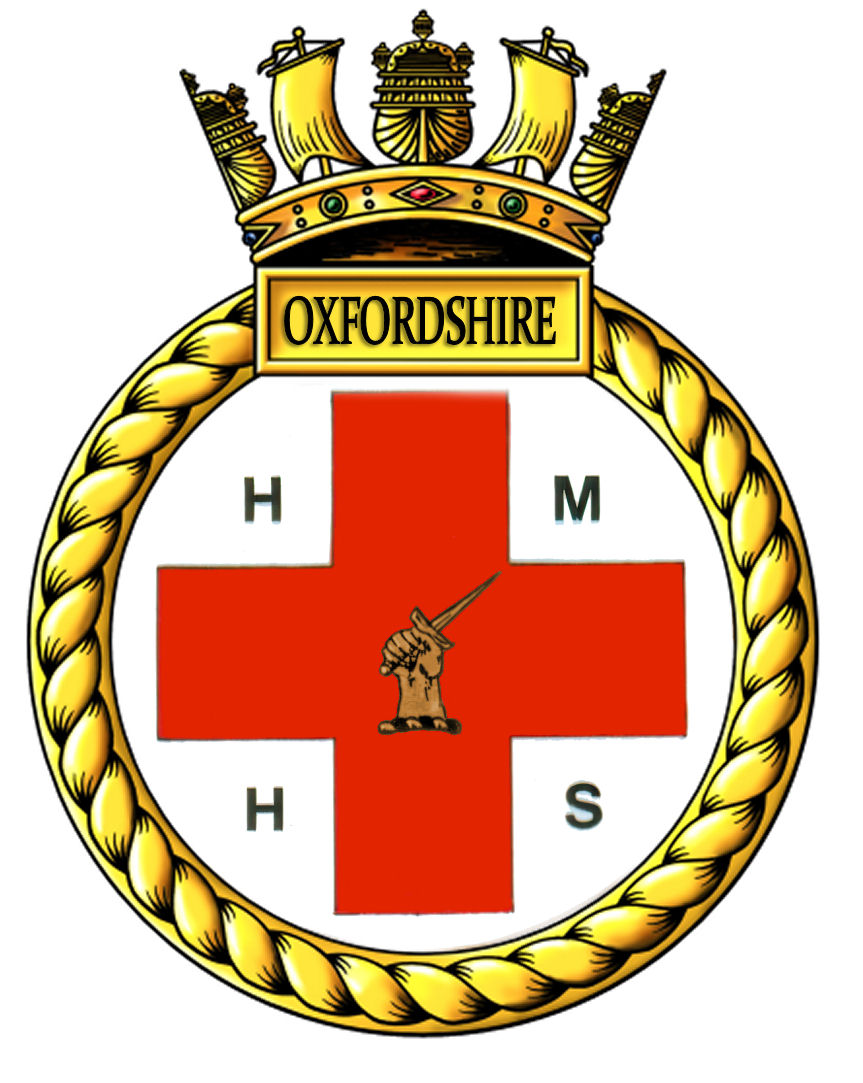
unofficial badge and motto
Battle Honours
None
Specification
Builder: Harland and Wolff, Belfast
Displacement: 8,623 Gross tons
Length: 474ft 7in
Beam: 53 ft
Draught: 22.9 ft
Propulsion: 2 x Quadruple-expansion steam engine, otwo propellers
Speed: 15 Knots
Armament: None
Crew complement: Unknown
Commanding Officers
Unknown
Senior Medical Officer
Surg. Captain H. D. Drennan, DSO, MB, Bch (ret) Sep 1939
Surg. Captain G. G. Vickery, OBE, MB, Bch (ret) Jul 41
Surg. Captain J. A. Maxwell, CVO, ODE, MB, FRCS Apr 43
Surg. Captain R.N.V.R., H. M. Willoughby, VD, MRCS, LRCP, DPU, DTM & H (act) Aug 44
Related items
None
Reminiscences
None
Gallery
None
H.M.H.S. OXFORDSHIRE
Read aloud
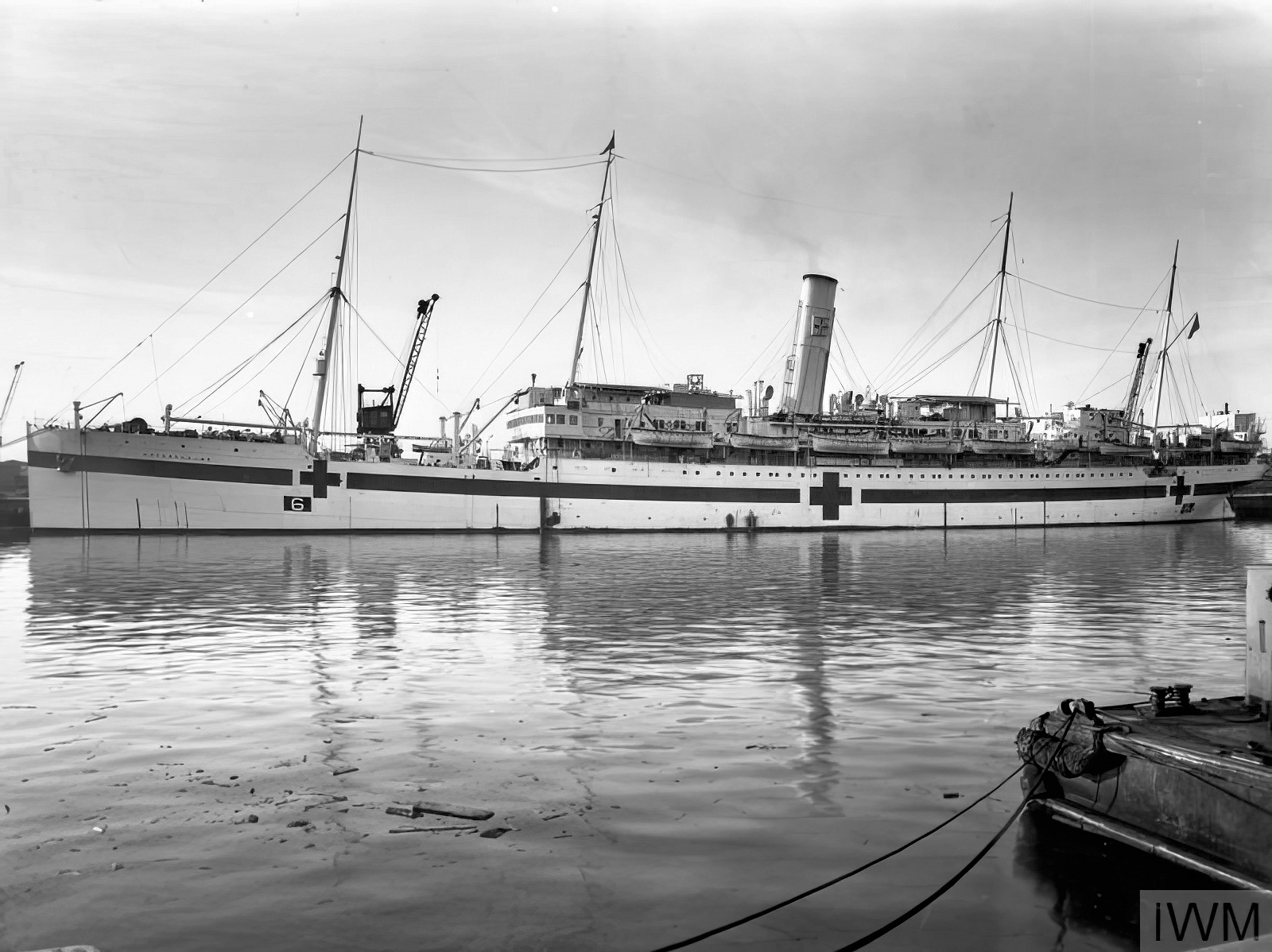
OXFORDSHIRE, Naval Hospital Ship No.6 © IWM FL 1722
Early history: WW1 Military Hospital Ship
OXFORDSHIRE was an 8,623 grt counter stern, twin screw, four master Passenger/Cargo steamer ordered by the Bibby Steamship Co. Ltd, Liverpool from Harland and Wolff, shipbuilders, Belfast. She was laid down in 1911 as Yard number 429 and launched on June 15th 1912 and completed on September 17th of that year. She was to operate on the company’s Liverpool to Rangoon service – Liverpool to Marseilles, Port Said, Port Suez, Colombo, Rangoon. She was designed to carry 247 First Class passengers, and thus offered spacious Promenade and Sports Decks, where all the ship board games were available. .
On August 2nd 1914, two days prior to the outbreak of the First World War, the S.S. OXFORDSHIRE was the very first merchant ship to be requisitioned for war duties; she was off the Isle of Wight en-route from Liverpool to London when she was requisitioned by the Admiralty for war service. She was order to Tilbury Docks were she was to be converted into a Naval Hospital Ship.
On completion of her very short conversion the OXFORDSHIRE emerged as His Majesty’s Hospital Ship No.1 with accommodation for with 562 patients. The medical staff comprised of 9 medical officers under Fleet Surgeon Francis Bolster, Senior Medical Officer. Commissioned on August 14th her first duty was to act as Base Hospital Ship at Scapa Flow [1]
At this stage of the war she had little to do at Scapa and the number of outpatients attending the ship did not warrant a facility of her size so other duties were sought. It was decided that she was to be transferred to the Army to undertake army hospital work and in the English Channel; she arrived at Devonport t on September 23rd 1914 and was subsequently manned by Royal Army Medical Corp (RAMC) personnel. [2]
Service as an Army Hospital Ship 1914 – 1919
OXFORDSHIRE now embarked an Army medical staff of 6 officers, 13 nurses and 41 other ranks, patient capacity remained at 562; 22 Officers, 216 cot cases and 324 sick berths. She operated in UK waters until April 1915 when she was deployed to Mudros, a small Greek port on the Mediterranean island of Lemnos to operate as a base hospital ship in support of the forces involved in the Gallipoli campaign. She made short voyages to the beaches of the Dardenelles to embark casualties for transport to Malta or Egypt when required; Lemnos was only 50 miles from the fighting, whereas the hospitals in Egypt and Malta were over 650 miles away, a voyage of 1½ days. In August No. 3 Australian General Hospital arrived on Lemnos just prior to start of the August offensive and were prepared to accept more serious cases at Mudros having operating theatres and surgeons on the staff. In later months, nearly all the patients were ill with either dysentery or paratyphoid.
On November 30th 500 troops were taken off ‘V’ beach on the Gallipoli peninsular and after a brief call back at Mudros most patients were put ashore to St. Georges Hospital at Malta; by this time the nature of casualties had changed, troops were caught in freezing weather on the Peninsula without adequate clothing, and many were admitted to the hospitals on Lemnos suffering from severe frostbite. She arrvi3ed off ANZAC (Australian and New Zealand Army Corps) beaches on December 1st and embarked 600 men, 200 of them stretcher cases, from the beach employing 10 of her own boats, all trips to and from shore carried out while the Turkish forces shelled the area, both on the beach and the shipping standing off shore. These men were taken to Alexandria, arriving there on December 5th; she Saied for Mudros again on the 8th. She remained based at Mudros until early December when the evacuation of the ANZAC troops from the Dardenelles began on the 15th, OXFORDSHIRE again bringing off the wounded in her own boats. The victorious Turks respected the Red Cross and did not fire on them. Over 5 nights, 36,000 troops were withdrawn to the waiting transport ships. The last party left in the early hours of December20th. OXFORDSHIRE disembarked some of her patients at Mudros before disembarking the remaining patients at Malta on January 1st 1916.

No. 3 Australian General Hospital at Mudros on the island of Lemnos, the harbour where OXFORDSHIRE was often moored ,can be seen in the background.
On her arrival back at Mudros she assisted with the evacuation of No. 3 Australian General Hospital to Egypt; begging on January 14th she embarked the unit’s 40 officers, 95 Nursing Sisters and 300 orderlies, together with their equipment and stores and sailed for Alexandria on the 17th.
After disembarking No. 3 Australian General Hospital OXFORDSHIRE prepared to sail for the UK, embarking patients and invalids from local hospitals for passage home. She arrived at Southampton on February 24th and was taken in hand for dockyard repairs, and possibly to be converted into an Ambulance Transport Ship. She appears to have returned to the Mediterranean on completion of this work and is recorded as being at Salonika in May 1916.
Retasked to operate in the Persian Gulf
OXFORDSHIRE was next assigned to operate in the Persian Gulf arriving at Port Said on July 31st on passage to Bombay which was to be her main port of operations for the next two years. From Bombay she operated as an Ambulance Transport making voyaged to Basra, Iraq, at the head of the Persian Gulf with calls at ports along the way until December of that year when she was switched to operate in East Africa waters, sailing for Dar-es-salaam on December 8th.
She spent the next 12 months carrying patients between Dar-es-salaam, Durban and Cape Town with an occasional visit to Zanzibar when the need to take on more coal arose; she mainly bunkered at Durban. One variation to this routine happened on September 28th 1917 when she arrived at Kilwa Kisiwani, Tanzania from Durban, here she embarked 562 patients before sailing for Dar-es-salaam the following day and arriving on the 30th
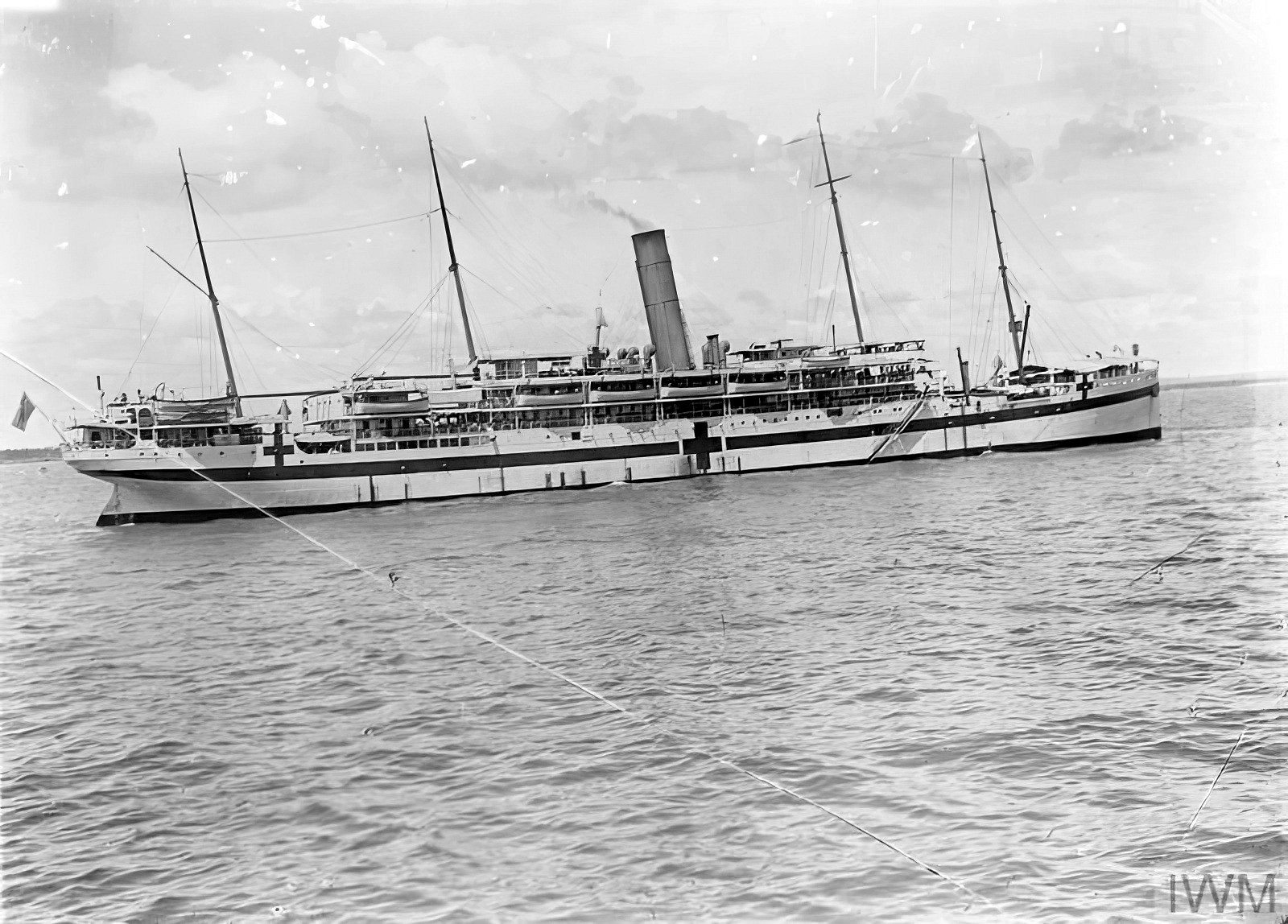
Military Hospital Ship OXFORDSHIRE at Dar-es-Salaam, 19 December 1916 © IWM Q 15677
Return to the UK and conversion for Trooping duties
In early 1918 the OXFORDSHIRE returned to the UK, transporting her last consignment of patients; on her arrival she was decommissioned as a hospital ship and redesignated as a troop troopship, receiving an overall grey paint scheme. By June 1918 she had sailed for her t=first trooping voyage, collecting Canadian troops for passage to Liverpool, leaving Halifax on June 25th. She was then loaned to the United States' Government, and made three trips from New York to Liverpool, carrying an average of over 1000 American troops.
In January 1919 she sailed from Liverpool bound for New Zealand and Australia carrying ANZAC troops, 1173 of all ranks, and 44 civilian passengers. She made the voyage via the Mediterranean, calling at Malta, Port Said, and Colombo, arriving at Auckland, New Zealand February 1st
She spent the whole of February in New Zealand, sailing on February 28th for Australia, arriving at Sydney on March 3rd. On March 10th she sailed for London via Bombay. She was released from military service on March 24th 1919 (at Bombay?) and returned to her owners Bibby Steamship Co. Ltd. During her time as a requisitioned vessel she had made 235 voyages, steamed 172,000 miles without a single breakdown and carried 50,000 wounded, the highest of any hospital ship in the war.
She appears to have continued operations as a troop transport under charter throughout 1919, again carrying Australian troops, she arrived at Cairns on August 10th to disembark the 9th Light Horse Regiment before calling at Fremantle on August 14th 1919 to disembark the 10th Light Horse Regiment, both of which had embarked at Port Said on July10th. In 1920 she returned to Harland and Wolff’s Belfast dockyard to be refurbished and converted to oil burning in preparation for resuming commercial services.
World War Two
On September 3rd 1939 OXFORDSHIRE was requisitioned, once again for war time service as a Naval Hospital Ship. Her conversion was carried out at the Royal Albert Dock in London and she emerged as Hospital Ship No.6. She was commissioned three weeks later on September 24th. She was manned by a 177 strong Merchant Navy crew and Master, while the hospital provided medical accommodation for 505 patients, including 20 officers, was under the command of Surgeon Captain H. D. Drennan, DSO, MB, Bch as Principal Medical Officer, in Charge of 98 medical staff, 10 medical officers, 1 Warrant Ward master, 1 Superintending Sister, 9 Nursing Sisters, and 77 sick Berth Attendants.
Base Hospital Ship Freetown, Sierra Leone
Hospital Ship No.6 left London on November 11th bound for Freetown to take up station as a Base Hospital Ship. She was to remain on station until February 1941, being relieved by H.M.H.S.
VASNA which arrived at Freetown on February 15th. After transferring her charges she sailed for Port Elizabeth, South Africa three days later to enter a dockyard and undergo a refit.
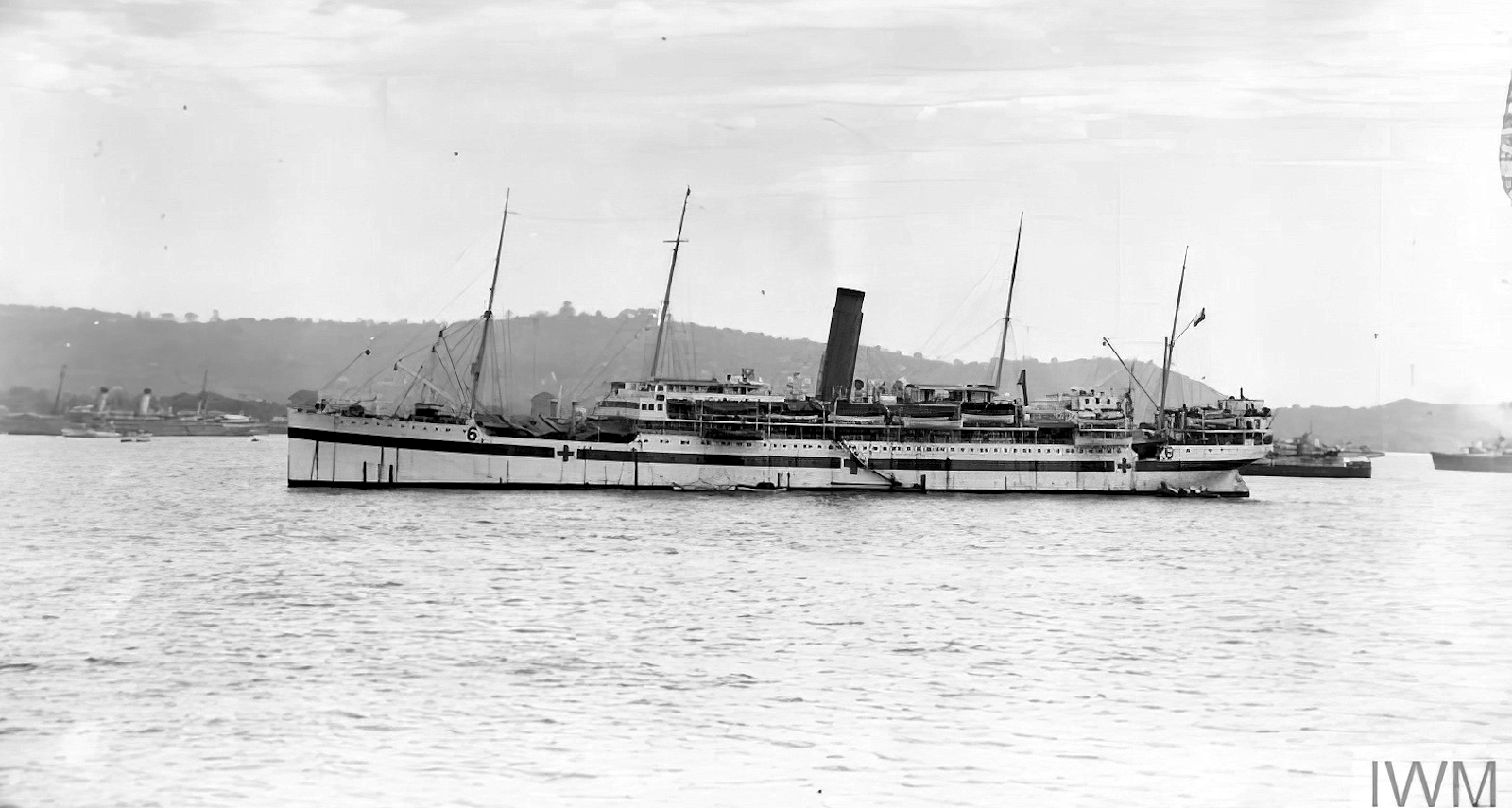
OXFORDSHIRE as Hospital Ship No.6 at Freetown April 1942 © IWM A 9224
She arrived at Cape Town on March 8th and remained in port for a week before sailing on the 17th and arriving oat Port Elizabeth on the 19th to enter the dockyard. On completion of her refit she sailed from Port Elizabeth on May 9th, arriving at Durban on the 10th to embark a large number of military invalids, sailing for Cape Town on the 13th. On the way to Freetown OXFORDSHIRE encountered and took aboard 58 persons, including one woman, survivors of the merchant ship the SS BENVRACKIE torpedoed and sunk on the same day as the Hospital Ship departed from Cape Town. She arrived back at Freetown on May 26th. Here the survivors were landed and 203 foreign invalids for onward passage to the UK were transferred to VASNA before she sailed on May 29th. Surg. Captain G. G. Vickery, OBE, MB, Bch (ret) arrived onboard as Principal Medical Officer during July 1941..
OXFORDSHIRE remained at Freetown as base hospital ship until July 1942, when she sailed for Cape Town on the 7th, arriving at Table Bay on the 30th. She now entered a dry dock for repairs to be carried out, the work being completed on August 17th. On the 19th she sailed for Durban where she embarked 234 military invalids on the 22nd before sailing to return to Freetown on the 25th. On arrival at Freetown on September 6th she embarked further invalids before sailing to return to the UK on the 11th. She arrived at Liverpool on September 22nd.
Reallocated to the Mediterranean Fleet for duties in North Africa
The ship was in Liverpool to undergo her first major refit since commissioning in 1939 and included improvements to her medical facilities and the comfort of her medical staff. This work was completed on November 2nd and she embarked stores and equipment in preparation for sailing on operational duties as a hospital carrier collecting casualties and invalids from ports on the North African coast.
She sailed from Liverpool on November 11th bound for Gibraltar where she arrived on December 2nd, departing for Algiers on the 10th, arriving there on the 11th. She sailed for Oran the next day arriving there o the 14th; she received 364 Naval, Military and Merchant Navy casualties from allied operations in North Africa. She spent the next five weeks in harbour at Oran where she received a number of survivors from the Destroyer HMS PARTRIDGE, sunk by torpedo, 18 of them were suffering from the effects of the explosion of the ship's depth charges at the time of her sinking. These survivors, while in the water, had been exposed to a blast pressure of between 1, 000 and 2,000 lb. per square inch. Four cases were fatal, but the remainder survived. It was fortunate at this time that the surgical specialist had considerable experience of this type of casualty, having been engaged on research work concerning immersion injuries earlier in the war.
OXFORDSHIRE remained in North Africa until the end of January 1943, sailing for Avonmouth for to deliver casualties for onward passage to UK hospitals and undergo repairs and arriving there on February 4th. On completion of the work she sailed on February 20th to return to the North African coast on March 11th, operating as a hospital carrier to collect more casualties and invalids before sailing for a second run to Avonmouth, via Belfast on the 21st, arriving on March 23rd. Surg. Captain J. A. Maxwell, CVO, ODE, MB, FRCS arrived on-board to trace over as Principal Medical Officer just prior to her sailing to return to the North African coast on April 1st. On this voyage she was to collect casualties from Algiers, Oran and Bone before sailing for the UK on May 12th. She made three more voyages to North African ports collecting patients particularly between Bone and Algiers, the last ended at Avonmouth on June 22nd. She evacuated 1,490 casualties from Bone, often under heavy fire, and over her five trips carried 1,831 casualties to the UK. OXFORDSHIRE was originally converted for operation as a static hospital ship, consequently she had a relatively small cot capacity, low speed, a lack of power boats, and poor manoeuvrability in small harbours. These disadvantages were overcome in part by local improvisation, and particularly by the expert handling and seamanship of the ship's master.
Hospital Ship No.6 sailed from Avonmouth on June 28th to return to the Mediterranean, this time in support of operation HUSKY, the Allied invasion of Sicily which began on the night of 9–10 July 1943 and ended on August 17th. Also operating in the support of these landings and subsequent incursion were the hospital Ships OPHIR, VASNA, and VITA on loan from the Eastern Fleet operating as Hospital Carriers.
OXFORDSHIRE called at Philippeville, Algeria on July 16th before arriving at Bizerte, Tunisia on July 22nd where she was to operate as a static hospital ship until she sailed f on September 2nd for Alexandria via Tripoli, arriving on the 7th to discharge patients to hospitals ashore. She sailed the next day for a round robin carrier voyage calling at ports in the eastern Mediterranean and Sicily ; she called at Bizerte on the 12th on passage to Salerno, Sicily before calling at Philippeville on the 16th, Syracuse, Sicily on September 21sth, Tripoli, Libya on the 28th, Catania and Augusta, Sicily on the 30th. She now took passage to Philippeville calling there on October 5th and continuing on to Bone, Algeria arriving on the 12th. From here she sailed for Tripoli on the 13th, arriving on the 15th and sailed for Alexandria on the 16th, she arrived there on the 19th, departing for a round trip voyage to Tripoli on the 20th.
On her arrival back art Alexandria she was taken in hand for repair work which was completed on November 19th. When she sailed for a round trip to Tripoli again, arriving back on the 26th. On the 29th she sailed for Italy, calling at Tripoli first on December 2nd, she arrived at Naples on the 7th and Taranto on the 11th before setting course for the western Mediterranean, calling at Algiers on the 14th and Philippeville on the 16th. She returned to Naples on December 22nd before sailing for Algiers again on the 28th. Arriving at Algiers on December 30th she sailed for the UKJ on New Year’s Day 1944.
She arrived at Avonmouth on January 7th 1944 to disembark patients before sailing for Swansea on the 9th to enter a dockyard for a month long refit. During the period July to December 1943 she steamed 9,222 miles and carried 2,312 patients.
Emerging on February 2nd she sailed on the first of three carrier voyages to Algiers to collect casualties and invalids for transport to the UK. On her fourth trip to Algiers she continued on to Italy, calling at Taranto on April 22nd and Naples on the 24th. From here she made three tips to the Anzio beachhead to evacuate casualties from the fighting in area and ferried them to Algiers, disembarking her last patients on June 1st. She now collected patients and invalids from Taranto, Alexandria and Syracuse before arriving back at Algiers on June 16th. A week later she sailed for the UK, arriving at Glasgow on June 27th to enter a dockyard for additional work, this included the construction of new storerooms, conversion of existing storerooms into a new ward of 86 beds and general repairs to plumbing and sanitation.
On leaving the dockyard she was allocate to act, temporarily, as base hospital ship at Scapa Flow and she arrived on station on July 25th, and returned to Glasgow on August 11th and entered another Clyde dockyard on the 14rth to be tropicalized in preparation for service in the Far East. Surg. Captain Maxwell left the ship at this time to take up a new appoint-met, he was to the Principle Medical Officer of the planned Auxiliary Hospital to open in Sydney Australia at the end of the year, receiving a promotion to acting Surgeon Rear Admiral. He was relieved by Surg. Captain R.N.V.R., H. M. Willoughby, VD, MRCS, LRCP, DPU, DTM & H. The work was complete d on September 8th and she then moved to a mooring at Greenock to store ship and make ready for departure on her next assignment, another tour in the Mediterranean collecting patients form North Africa, Sicily and Italy; this time calling at additional ports on the Italian East coast. She sailed from Greenock on September 26th, calling at Gibraltar, Algiers, Bone before arriving at Taranto on October 7th. On the 10th she sailed around the toe of Italy and arrived at Ancona on the 12th and Bari on the 14th. On the 15th she sailed for Sicily calling at Catania and Syracuse on the 17th before heading North again for Bari and Brindisi calling at both ports on the 19th. She called at Ancona on the 24th and Bari on the 29th before returning to Taranto, arriving on the 30th.
Reallocated for service with the British Pacific Fleet
She was to remain at Taranto until November 4th when she dialed for Port Said serving on the 8th to transit the Canal on passage to India. Here she discharged her European patients and embarked 329 Indian military invalids for passage to Bombay. [3] She arrived at Bombay on November 20th before calling at Karachi to disembark her remaining Indian invalids before continuing on to Colombo, Ceylon arriving on the 30th. From here she dialled for Fremantle, Australia on December 3rd. She spent three days at Fremantle, sailing on the 16th for Sydney where she arrived, one day behind schedule, on Christmas Day, 1944.
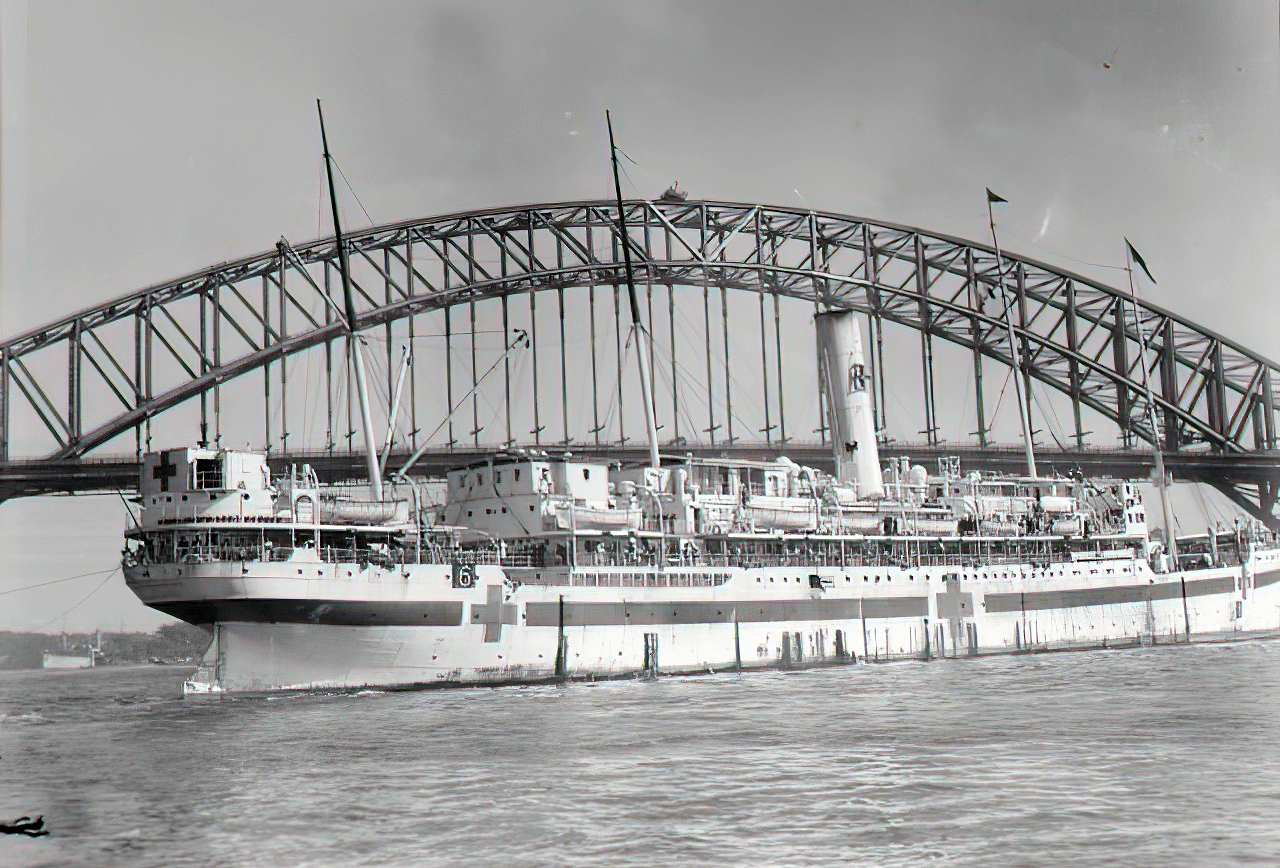
OXFORDSHIRE maneuvering in Sydney harbour
At Sydney she assumed the role of base hospital ship pending the opening of the R.N. Auxiliary Hospital at Herne Bay, Sydney. On release from this duty she sailed for Brisbane on February 22nd on passage to Manus, the Admiralty Islands where she was to join the British Pacific Fleet Train. She arrived at Manus on March 1st and assumed the role of Base Hospital ship until the 25th when she sailed for Leyte, the Philippines.
OXFORDSHIRE arrived at Leyte Island on March 27th 1945 and anchored in San Pedro Bay near the other ships of the Fleet Rain in the advanced base anchorage. She was to remain at anchor ready to receive casualties ferried back from the forward area by Escort Aircraft Carriers (CVEs) of the Air Train on completion of their replenishment sorties. The first casualties arrived on board the CVE SLINGER on April 7th, these included men from the four Fleet Carriers INDEFATIGABLE (16), ILLUSTRIOUS, INDOMITABLE, and VICTORIOUS injured during a kamikaze attack on April 1st. The carriers formed the main strike element of Task Force 57 (the BPF) and were conducting strikes against Japanese airfields on the Islands of the Sakishima-Gunto group in operation ICEBERG, a joint Brutish and American operation in conjunction with US N Task Force 58. OXFORDSHIRE was the only British medical support unit in the forward base until mid-April when she was joined by two others: the New Zealand Hospital Ship MAUNGANUI arrived on April 14th, and the Dutch Hospital Ship TJITJALENGKA on April 19th.
OXFORDSHIRE and MAUNGANUI were to operate as Auxiliary Naval Hospitals at Leyte, each ship being responsible for half the ships moored in the anchorage. Patients were discharged to their own ship or, if this had sailed, to a ship which acted as a pool depot. Some serious cases were transferred to ships returning to Australia. TJITJALENGKA was to be called forward when needed to operate in the forward area.
On April 23rd the ships of TF 57 anchored in San Pedro Bay, 32 days after sailing from Ulithi Atoll; 26 of these days on operations, and 12 strike days had been carried out. Damage repair and defect rectification were the priority and the opportunity was taken to embark store and replacement aircraft. The hospital ships were ready for their arrival; The New Zealand manned cruiser GAMBIA arrived with an epidemic of mumps was still running its course with twenty-three cases isolated on board, in addition to forty already in the New Zealand hospital ship MAUNGANUI. By the end of the month when TF 57 sailed from Leyte on May 1st to return to the operational a large number had returned to duty, but there were still eight cases on GAMBIA and twenty-seven in the MAUNGANUI.
The Japanese hit the Fleet Carriers hard on their return to strike the Islands of the Sakishima-Gunto group with increased kamikaze attacks. A second group of casualties arrived on May 8th when the CVE STRIKER arrived at Leyte from the replenishment area carrying 35 casualties, all from the carrier FORMIDABLE injured by Kamikaze attack on May 4th; these were transferred to MAUNGANUI. [4] This was quickly followed on May 12th by a further 20 casualties delivered to OXFORDSHIRE by the CVE SPEAKER, 1 from FORMIDABLE and 19 from VICTORIOUS which was attacked by Kamikaze aircraft on the 9th.
The frequency of the Kamikaze attacks and the potential delays in evacuating the resulting casualties using only the replenishment CVEs [5] prompted the Commander, British Pacific Fleet to call TJITJALENGKA forward to operate in the vicinity of the replenishment area; she sailed from San Pedro Bay on May 10th to rendezvous with the Logistic Support Group.
By the third week of May the BPF was about to undertake it’s final round of strike days before withdrawing to Australia for a prolonged replenishment and repair period before commencing strikes against mainland d Japan in July. Many of the ships of the Fleet Train also began to withdraw from Leyte to Manus, some to Australia. With TJITJALENGKA now in the replenishment area and receiving casualties directly both MAUNGANUI and OXFORDSHIRE withdrew to return to Australia, via Manus; MAUNGANUI sailed on the 21st bound for Sydney and OXFORDSHIRE on the 24th for Brisbane, both ships arrived in port on June 7th.
Loaned to the US Seventh Fleet
ON arrival at Brisbane OXFORDSHIRE discharged her invalids to the R.N. Auxiliary Hospital , Brisbane . She spent the next three weeks at Brisbane, all personnel were given local leave in watches while the ship took on stores and made good repairs. Sher sailed from Brisbane on June 28th to return to Leyte, calling at Manus on July 4th. On reaching Leyte on July 14th OXFORDSHIRE was transferred to eh US Seventh Fleet for temporary duty as base hospital at Subic Bay. She was at Subic Bay when the Japanese surrendered on August 15th.
Evacuation of P.O.W.s and internees from Hong Kong
As early as August 10th it became clear that that Japan was willing to accept the terms of surrender and all of the ships in Australian waters had been reallocated to form Task Group 111 in readiness to reoccupy the former Crown Colonies; Task Group 111.2 (TG111.2 )was assembled to reoccupy Hong Kong and comprised the Carriers INDOMITABLE and VENERABLE, Cruisers SWIFTSURE, EURYALUS, and PRINCE RUPERT (RCN) with Destroyers KEMPENFELT, URSA, WHIRLWIND and QUADRANT; they arrived at Subic Bay in late August to await orders. OXFORDSHIRE and MAUNGANUI were also present at Subic Bay were attached to the Task Group.
TG111.2 sailed from Subic Bay on August 27th and met with the advance elements of TG111.4 (Battleship ANSON and her escorting destroyers) off Hong Kong on the 29th to await completion of minesweeping operations before entering the harbour. The main elements of TG 111.2 and 111.4 entered Hong Kong on August 30th, VENERABLE was ordered to remain at sea and maintain a continuous air patrols over the colony. The two hospital ships entered harbour on September 2nd to embark recently liberated POWs and civilian internees from camps in Hong Kong.
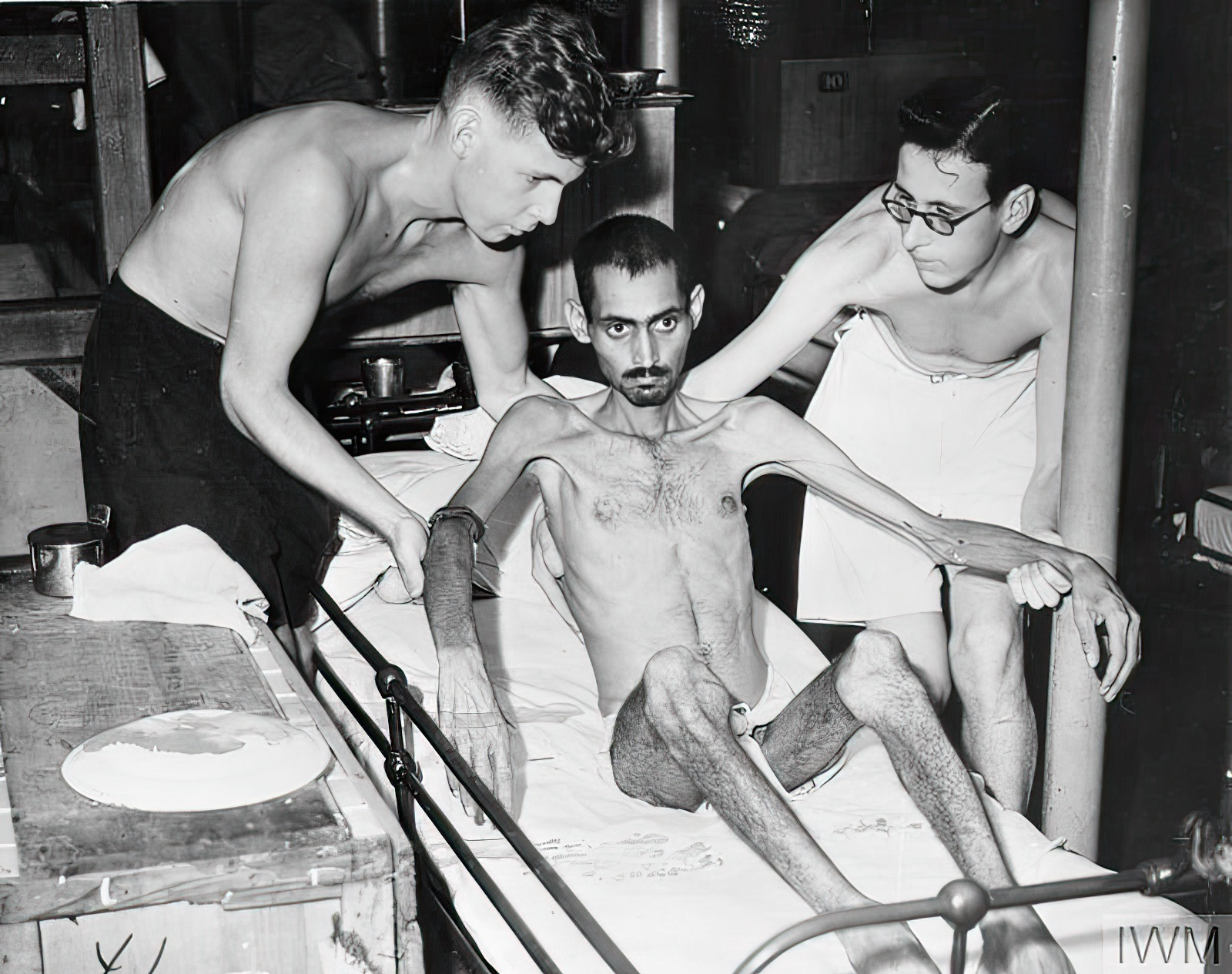

September 2nd 1945. left: A severely malnourished Indian prisoner of war from Hong Kong is attended to by nursing staff (Sick Berth Attendant Hodson and Leading Sick Berth Attendant Mitchell) on board the hospital ship OXFORDSHIRE after liberation. © IWM A 30522 Right: A nursing sister assesses a former POW suffering from severe case of malnutrition taken from the Central Hospital, Kowloon, and Hong Kong. © IWM A 30523f
Once secured alongside at Kowloon OXFORDSHIRE embarked 321 of the most serious hospital cases from Stanley Camp and 60 internees, 16 of which were women. Amongst these were Matron O. H. Franklin, the Naval Matron of the Royal Naval Hospital, Hong Kong and nursing sisters Miss G. M. Griffiths, and Miss I. Rollin, who had been taken prisoner when the Colony fell to the Japanese on Christmas Day 1941. The ship sailed for Manilla the following day, arriving on the 5th. Here she landed 35 sick Canadian subjects before she sailed for Brisbane on the 7th. Calling at Manus on route, she arrived at Brisbane on the 19th she disembarked Queensland patients, including 87 stretcher cases which were ferried to the 102nd Australian General Hospital, Brisbane in 21 ambulances. Of her charges 36 per cent were suffering from pellagra, 23 per cent from malaria, 16 per cent from beriberi, and 3 per cent from ascariasis (a type of roundworm), and the remainder from various forms of dysentery. However, with careful nursing, the majority of the ex-POWs had made a remarkable recovery within a few days, several gaining as much as 10 to 14 lbs. in weight. Sadly seven patients died during the voyage but on a happier note a baby was born on board.
OXFORDSHIRE docked at Sydney on the 21st and all remaining patients were transported to the R.N. Auxiliary Hospital at Herne Bay, which was a P.O.W. reception and rehabilitation centre. Once all patients had disembarked the ship entered dockyard for repairs which were completed on the 27th. After storing ship OXFORDSHIRE departed from Sydney on September 29th to return to Hong Kong, calling at Manus and Leyte before arriving back at Kowloon on October 26th. She now embarked 399 ex-internees, including 214 women and 57 children.
Return to the UK to Pay Off
OXFORDSHIRE now sailed to return to the UK, a number of these passengers were landed at Singapore, before arrived at Liverpool on December 5th, 1945 where the remainder disembarked. Shortly after this date she ceased to be a naval hospital ship.
During the whole war period approximately 22,351 patients were admitted to H.M.H.S. OXFORDSHIRE, in addition to which 5,715 outpatients attended the ship for various reasons.
Post naval use
On the 28th of February 1946 she was transferred to the Army for use as a military Hospital Carrier and was used to bring the sick home from the near and Far East. She suffered damage to her starboard propeller while docking at Liverpool on July 2nd and entered a dockyard for repairs. On release from hospital duties she was employed on trooping duties and repatriated Indian troops from Basra to Bombay as well as making four North Atlantic crossings with refugees. In 1948 she arrived home with troops from Palestine arriving at Southampton on July19th. On 8th September she made one more voyage on charter to Jeddah with pilgrims before she was reconditioned by Harland & Wolff at Liverpool. In April 1949 she made the first sailing for the International Refugee Organisation to Australia with emigrants and in 1950 reverted to trooping duties between Trieste and Port Said.
She finished trooping in February 1951 and was returned to her owners, the Bibby Line Ltd on March 8th 1951 who sold her to the Pan-Islamic Steamship Co. of Karachi and was officially released from ministry of transport service on April 3rd. Now renamed the SS SAFINA-EL-ARAB she sailed from Liverpool On April 13th for Karachi. She was the company’s first vessel and she was deployed on the Karachi - Jeddah Pilgrim service between June and October before switching to operate between Karachi and Chittagong. She was taken out of service in 1958 and scrapped at Karachi after 46 years of impeccable service.
Last modified: 16 August 2023
Primary information sources
Additional sources:
BT 389/31/97 WW2 Ship's record card held by the UK National Archive
WO-95-4152-1, WO-95-4152-2, WO-95-4152-3 Hospital Ships Line of communications units, HHMS VITA June 1917 – February 1921 held by the UK National Archive
(1954) Surgeon Commander J. L. S. COULTER, D.S.C., R.N., ‘THE ROYAL NAVAL MEDICAL SERVICE’ London, Her Majesty's Stationery Office - Volume 1'Administraion'
Comments (0)